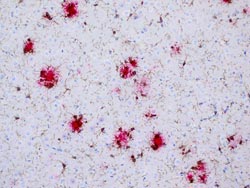New Findings on the Brain’s Immune Cells during Alzheimer’s Disease Progression

Immune cells of the brain, the microglia (brown), cluster around the beta-amyloid deposits (red) in a mouse model for Alzheimer’s disease. Photo: Frank Heppner/ Copyright: Charité<br>
A study by researchers of the Max Delbrück Center for Molecular Medicine (MDC) Berlin-Buch and Charité – Universitätsmedizin Berlin has now shed light on these mysterious microglia during the progression of Alzheimer’s disease. (PLoS One, doi:10.1371/journal.pone.0060921)*.
Dr. Grietje Krabbe of the laboratory of Professor Helmut Kettenmann (MDC) and Dr. Annett Halle of the Neuropathology Department of the Charité headed by Professor Frank Heppner demonstrated that the microglial cells around the deposits do not show the classical activation pattern in mouse models of Alzheimer´s disease.
On the contrary, in the course of the Alzheimer’s disease they lose two of their biological functions. Both their ability to remove cell fragments or harmful structures and their directed process motility towards acute lesions are impaired. The impact of the latter loss-of-function needs further investigation. The plaques consist of protein fragments, the beta-amyloid peptides, which in Alzheimer’s disease are deposited in the brain over the course of years. They are believed to be involved in destroying the nerve cells of the affected patients, resulting in an incurable cognitive decline.
However, just why the microglial cells, which cluster around the deposits, are inactivated or lose their functionality is still not fully understood. The researchers concluded that this process occurs at a very early stage of disease development and is likely triggered by the beta-amyloid. This is confirmed by the fact that the loss-of-function of the microglial cells in the mice could be reversed by beta-amyloid antibodies thereby decreasing the beta-amyloid burden. According to the researchers, the potential to restore microglial function by directed manipulation should be pursued and exploited to develop treatments for Alzheimer’s disease.
**Functional impairment of microglia coincides with beta-amyloid deposition in mice with Alzheimer-like pathology
Grietje Krabbe1,4,*, Annett Halle2,3,*, Vitali Matyash1, Jan L Rinnenthal2, Gina D Eom2, Ulrike Bernhardt2, Kelly R Miller2, Stefan Prokop2, Helmut Kettenmann1,#, Frank L Heppner2,#
1Max Delbrueck Center for Molecular Medicine (MDC), Robert-Roessle-Str. 10, 13125 Berlin, Germany
2Department of Neuropathology, Charité-Universitätsmedizin Berlin, Charitéplatz 1, 10117 Berlin, Germany
3Center of Advanced European Studies and Research (caesar), Ludwig-Erhard-Allee 2, 53175 Bonn, Germany
4Present address: Gladstone Institute of Neurological Disease, 1650 Owens Street, San Francisco, CA 94158, USA
*,# These authors contributed equally to this work.
Contact:
Barbara Bachtler
Press Department
Max Delbrück Center for Molecular Medicine (MDC) Berlin-Buch
in the Helmholtz Association
Robert-Rössle-Straße 10; 13125 Berlin, Germany
Phone: +49 (0) 30 94 06 – 38 96; Fax: +49 (0) 30 94 06 – 38 33
e-mail: presse@mdc-berlin.de
Media Contact
More Information:
http://www.mdc-berlin.de/All latest news from the category: Life Sciences and Chemistry
Articles and reports from the Life Sciences and chemistry area deal with applied and basic research into modern biology, chemistry and human medicine.
Valuable information can be found on a range of life sciences fields including bacteriology, biochemistry, bionics, bioinformatics, biophysics, biotechnology, genetics, geobotany, human biology, marine biology, microbiology, molecular biology, cellular biology, zoology, bioinorganic chemistry, microchemistry and environmental chemistry.
Newest articles

Recovering phosphorus from sewage sludge ash
Chemical and heat treatment of sewage sludge can recover phosphorus in a process that could help address the problem of diminishing supplies of phosphorus ores. Valuable supplies of phosphorus could…

Efficient, sustainable and cost-effective hybrid energy storage system for modern power grids
EU project HyFlow: Over three years of research, the consortium of the EU project HyFlow has successfully developed a highly efficient, sustainable, and cost-effective hybrid energy storage system (HESS) that…

After 25 years, researchers uncover genetic cause of rare neurological disease
Some families call it a trial of faith. Others just call it a curse. The progressive neurological disease known as spinocerebellar ataxia 4 (SCA4) is a rare condition, but its…





















